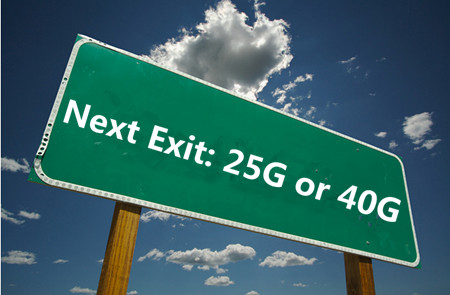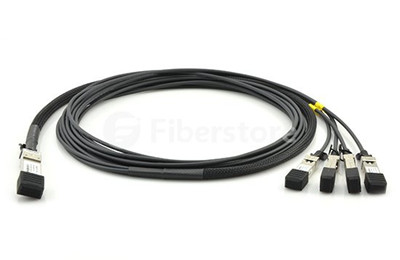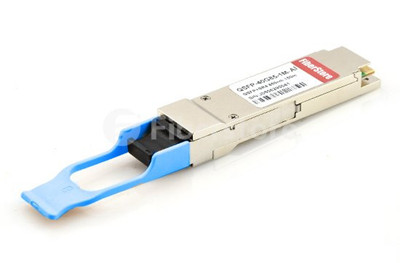When you look at the evolution of networking and the data that drives it, there is no surprise that Ethernet has been and will continue to be the most widely used network interface. Consumers and network designers wish to smoothly migrate to higher network speed—100G/400G without compromising quality. Ethernet speed upgrade path was clearly defined as from 10G,40G to 100G. But recently a new migrate path (10G-25G-100G) was gradually accepted by subscribers. For those who need to migrate their network to adopt to the big data age, choose 25G or 40G Ethernet, that is the question! This article provides the pros and cons of 25G and 40G Ethernet network. You will get your own answer at the end of it.

Here Comes 25 Gigabit Ethernet
25 Gigabit Ethernet has passed the first hurdle in the IEEE standards body with a successful Call for Interest (CFI) in July, 2014. It is a proposed standard for Ethernet connectivity that will benefit cloud and enterprise data center environments. 25 GbE leverages technology defined for 100 Gigabit Ethernet implemented as four 25 Gbit/s lanes (IEEE 802.3bj) running on four fibers or copper pairs. Telecom giants like Google, Microsoft, Arista, and Mellanox are pushing the development of a 25 Gigabit Ethernet standard for top-of-tack server networking. Relevant transceiver modules and optical cables are developed to support this technology.
25 Gigabit Ethernet has passed the first hurdle in the IEEE standards body with a successful Call for Interest (CFI) in July, 2014. It is a proposed standard for Ethernet connectivity that will benefit cloud and enterprise data center environments. 25 GbE leverages technology defined for 100 Gigabit Ethernet implemented as four 25 Gbit/s lanes (IEEE 802.3bj) running on four fibers or copper pairs. Telecom giants like Google, Microsoft, Arista, and Mellanox are pushing the development of a 25 Gigabit Ethernet standard for top-of-tack server networking. Relevant transceiver modules and optical cables are developed to support this technology.
40G Ethernet Network
The IEEE P802.3ba 40G and 100G Ethernet Task Force was formed to develop a 40 Gigabit Ethernet and 100 Gigabit Ethernet draft standard. At the physical layer, 40G Ethernet is essentially 4×10G lanes. Standards-based 40G Ethernet switches and routers are starting to show up in enterprise networks, following ratification of the IEEE 802.3ba specification in mid-2010. QSFP+ modules and 40G DAC cables are introduced to back 40G networking, which are warmly welcomed by network designers. For example, QSFPP-4X10GE-LR (see in Figure 2) is compatible Juniper QSFP+ transceiver. It can be used in a 4×10G modules with 10GBASE-LR interfaces.
The IEEE P802.3ba 40G and 100G Ethernet Task Force was formed to develop a 40 Gigabit Ethernet and 100 Gigabit Ethernet draft standard. At the physical layer, 40G Ethernet is essentially 4×10G lanes. Standards-based 40G Ethernet switches and routers are starting to show up in enterprise networks, following ratification of the IEEE 802.3ba specification in mid-2010. QSFP+ modules and 40G DAC cables are introduced to back 40G networking, which are warmly welcomed by network designers. For example, QSFPP-4X10GE-LR (see in Figure 2) is compatible Juniper QSFP+ transceiver. It can be used in a 4×10G modules with 10GBASE-LR interfaces.
25 Gigabit or 40 Gigabit Ethernet for Your Server
The most obvious feature of 25 Gigabit is described in two words—single lane. The phrase refers to the electrical signaling on the chip that would power an Ethernet port, while the design of 40 GbE was based on 10 GbE. Originally, 100 GbE had a similar heritage, with its initial design in 2010 using 10 lanes of 10 Gbps. This is the first generation of 100G transport links. As standards bodies sought to improve the efficiency of 100 GbE in the coming years, its second generation consists of four lanes of 25 Gbit/s Ethernet on four fiber or copper pairs. This will be disruptive to the 10G and 40G infrastructure.
The most obvious feature of 25 Gigabit is described in two words—single lane. The phrase refers to the electrical signaling on the chip that would power an Ethernet port, while the design of 40 GbE was based on 10 GbE. Originally, 100 GbE had a similar heritage, with its initial design in 2010 using 10 lanes of 10 Gbps. This is the first generation of 100G transport links. As standards bodies sought to improve the efficiency of 100 GbE in the coming years, its second generation consists of four lanes of 25 Gbit/s Ethernet on four fiber or copper pairs. This will be disruptive to the 10G and 40G infrastructure.
In addition, the proposed 25 GbE standard reduces the number of lanes on the chip makes it less expensive to produce and less power-hungry. It also simplifies the process with just minor changes for forward error correction and lane alignment when compared to 40 GbE. To sum up, getting 25 GbE performance for the same price of 10G combined with reduced operating costs, which makes itself a compelling proposal for migration.
On the other hand, driven by cloud computing, mobile broad-band and IPTV for higher user bandwidth, demand for 40G transport links is growing quickly. 40G links has been deployed for more than 5 years. Compared to 25GbE, it has a longer history. And a good news is that advances in semiconductor technology and innovative designs are reducing the cost of 40G systems. High-speed serial links, flexible interfaces, integrated packet, lower power and less silicon real estate are all helping telecom manufacturers deliver cost-effective solution to upgrade from 10G to 40G.
The 40GbE specification defines a wide range of port types and has been ratified by IEEE. 40G optical equipment are all compatible with the existing 10G devices. Take 40G-QSFP-4SFP-C-0101 (see in Figure 3) as an example, it is the compatible Brocade QSFP+ to 4SFP+ Passive Breakout Copper Cable, which offer a cost-effective way to establish a 40G link between QSFP port and SFP+ within racks and across adjacent racks. However, 25GbE transceiver modules like QSFP28 and SFP28 will not be compatible with the existing QSFP+ and SFP+ cable assemblies. Which will cause trouble to users. Many experts believe that if people agree to add 40GbE instead of endlessly debating will lead to faster standards completion.

Right Move at the Right Time
Planning for migration to higher-speed Ethernet can feel daunting as telecom experts hold different opinions towards the future of 25G and 40G. Some believe that the dominant next-generation server connection speed is going to be 25G, but some confirm that 40G between switches is expected to remain and will not be affected by this development. Just remember to make the right move at the right time. Fiberstore is working on providing cost competitive longer reach option for mainstream customers. We are very glad to offer our expertise in choosing the physical infrastructure that best meets your needs.
Planning for migration to higher-speed Ethernet can feel daunting as telecom experts hold different opinions towards the future of 25G and 40G. Some believe that the dominant next-generation server connection speed is going to be 25G, but some confirm that 40G between switches is expected to remain and will not be affected by this development. Just remember to make the right move at the right time. Fiberstore is working on providing cost competitive longer reach option for mainstream customers. We are very glad to offer our expertise in choosing the physical infrastructure that best meets your needs.


Thank you for the information Fiber optic network cabling
ReplyDelete